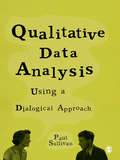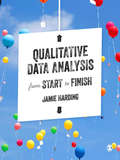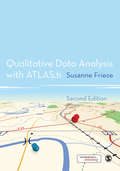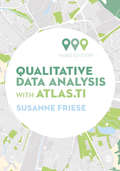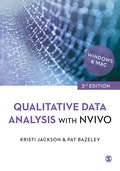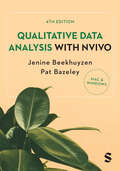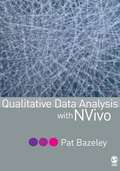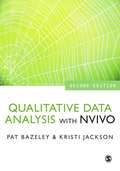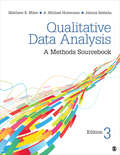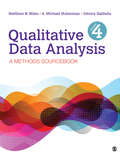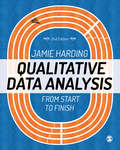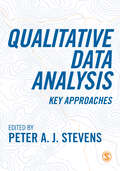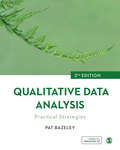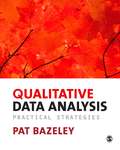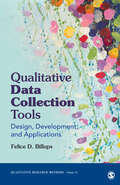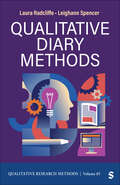- Table View
- List View
Qualitative Data Analysis Using a Dialogical Approach
by Dr Paul SullivanIn this important new text, Paul Sullivan introduces readers to a qualitative methodology rooted in the analysis of dialogue and subjectivity: the dialogical approach. Sullivan unpacks the theory behind a dialogical approach to qualitative research, and relates issues of philosophy and methodology to the practical process of actually doing qualitative research. Sullivan's book foregrounds the role of atmosphere, subjectivity and authorial reflection within texts. His work also enables the researcher to attend to the conflicts, judgments and interpretive activities that take place in language use. Practically speaking, the dialogical approach enables analysis of direct and indirect discourse, speech genres, hesitations, irony and a variety of other conditions that shape our understanding of dialogue in context. As well as exploring the theory behind this innovative method, Sullivan provides sound practical advice that recognises the everyday analytic needs of the reader. Topics include: * The theoretical foundations of the approach * The role of subjectivity in qualitative research * Data preparation and analysis * The future of the approach Theoretical discussion is consistently accompanied by research examples and suggestions as to how the dialogical approach could be used in the reader's own research. This important and timely book is ideal for any reader who wants to do research with dialogue and who is keen to attend to the full nuances and complexities of discourse.
Qualitative Data Analysis from Start to Finish
by Jamie HardingAre you new to qualitative research? Are you planning to do interviews or focus groups and wondering what on earth you'll do with the data once it's collected? Do you have a pile of transcripts staring at you right now and are you lost as to how to identify themes, code your data and work out what it all means? Fear not, help is here! In this brilliant new book, Jamie Harding breaks down the process of analysing qualitative data into simple, retraceable steps. After providing some top tips for designing your research and collecting your data, he takes you through the different stages of analysis, from the first reading of your transcripts, to presenting your findings in a report or dissertation. For each stage of the process there are demonstrations using real data and exercises for you to perform yourself. He unpicks what happens behind the scenes in qualitative data analysis - the bit that's hard to learn without seeing it happen and trying it for yourself. While acknowledging that there are many different forms that qualitative data analysis can take, the book provides a series of ideas and examples that you will find invaluable when analysing your own data. This book is perfect for all social science students who are struggling with data analysis and are looking for someone to guide the way.
Qualitative Data Analysis with ATLAS.ti
by Susanne FrieseQualitative Data Analysis with ATLAS.ti is the very first book designed to guide you step-by-step through your research project using ATLAS.ti. In the book, you will find clear, practical advice on preparing your data, setting up a new project in ATLAS.ti, developing a coding system, asking questions, finding answers and preparing your results. The book features: - methodological as well as technical advice - numerous practical exercises and examples - screenshots showing you each stage of analysis - a companion website with online tutorials and data sets Susanne Friese teaches qualitative methods at the University of Hanover and at various PhD schools, provides training and consultancy for ATLAS.ti at the intersection between developers and users.
Qualitative Data Analysis with ATLAS.ti
by Susanne FrieseNow updated to cover latest versions and featuring instructions for both Mac and Windows users, this book is still the go-to source of support for getting to grips with qualitative data analysis using ATLAS.ti. With over twenty years of experience using, developing, and teaching ATLAS.ti, Susanne Friese is the perfect data analysis tour guide. Aware of common challenges and sticking points, she eases readers from readying and organizing data into coding and querying it, providing not only tips on how to prepare for analysis, but also the tools and technical know-how needed to observe, examine, and discuss data. Placing quick software ‘skills training’ tutorials alongside different stages of the data analysis process, she gives readers the opportunity to integrate software training with their actual analysis.
Qualitative Data Analysis with ATLAS.ti
by Susanne FrieseNow updated to cover latest versions and featuring instructions for both Mac and Windows users, this book is still the go-to source of support for getting to grips with qualitative data analysis using ATLAS.ti. With over twenty years of experience using, developing, and teaching ATLAS.ti, Susanne Friese is the perfect data analysis tour guide. Aware of common challenges and sticking points, she eases readers from readying and organizing data into coding and querying it, providing not only tips on how to prepare for analysis, but also the tools and technical know-how needed to observe, examine, and discuss data. Placing quick software ‘skills training’ tutorials alongside different stages of the data analysis process, she gives readers the opportunity to integrate software training with their actual analysis.
Qualitative Data Analysis with NVivo
by Dr. Kristi Jackson Dr. Pat BazeleyEngaging and accessible, this book offers students a complete guide to using NVivo for qualitative data analysis. Drawing on their wealth of expertise, the authors offer detailed, practical advice that relates to students’ own experience and research projects. Packed with real-world examples and case studies, the book supports students through every stage of qualitative data analysis. The Third Edition: Contains fully integrated instructions for using NVivo on both Mac and PC, with screenshots and click-by-click guidance. Seamlessly interweaves theory and practice in easy-to-follow steps. Empowers students to develop their critical thinking. Accompanied by video tutorials for both Mac and PC, web links and a host of other helpful online resources, this step-by-step book removes students' anxiety about tackling data analysis. Whether for advanced researchers or those approaching the task for the first time, this clear, yet comprehensive guide is the perfect companion for anyone doing qualitative data analysis with NVivo.
Qualitative Data Analysis with NVivo
by Dr. Kristi Jackson Dr. Pat BazeleyEngaging and accessible, this book offers students a complete guide to using NVivo for qualitative data analysis. Drawing on their wealth of expertise, the authors offer detailed, practical advice that relates to students’ own experience and research projects. Packed with real-world examples and case studies, the book supports students through every stage of qualitative data analysis. The Third Edition: Contains fully integrated instructions for using NVivo on both Mac and PC, with screenshots and click-by-click guidance. Seamlessly interweaves theory and practice in easy-to-follow steps. Empowers students to develop their critical thinking. Accompanied by video tutorials for both Mac and PC, web links and a host of other helpful online resources, this step-by-step book removes students' anxiety about tackling data analysis. Whether for advanced researchers or those approaching the task for the first time, this clear, yet comprehensive guide is the perfect companion for anyone doing qualitative data analysis with NVivo.
Qualitative Data Analysis with NVivo
by Pat Bazeley Jenine BeekhuyzenLooking to use NVivo in your qualitative research? With easy-to-use instructions and screenshots for both Windows and Mac users, this book first covers the basics of coding in NVivo before helping you extend your knowledge and confidence using the software. But this is more than just a ‘how to’ software manual. Each chapter offers rich, methodological discussions that interweave qualitative thinking with technology, enabling you to develop a sophisticated research practice. Starting with how to navigate the software before moving on to different types of data you might use - such as text, images, and social media data - and how to code and visualise that data, each chapter helps you develop your skill in using NVivo to support effective qualitative analysis. The book also: Helps you understand why and when to use NVivo tools and how to combine them creatively; Includes a new chapter on visualising and reporting on your data using NVivo; Provides practical support for using NVivo 14, including fully updated screenshots, click-by-click instructions, screencast videos, and datasets for you to try what you’ve learned. Designed for anyone who wants to use NVivo in their research, this book is the go-to for conducting robust qualitative data analysis.
Qualitative Data Analysis with NVivo
by Pat Bazeley Jenine BeekhuyzenLooking to use NVivo in your qualitative research? With easy-to-use instructions and screenshots for both Windows and Mac users, this book first covers the basics of coding in NVivo before helping you extend your knowledge and confidence using the software. But this is more than just a ‘how to’ software manual. Each chapter offers rich, methodological discussions that interweave qualitative thinking with technology, enabling you to develop a sophisticated research practice. Starting with how to navigate the software before moving on to different types of data you might use - such as text, images, and social media data - and how to code and visualise that data, each chapter helps you develop your skill in using NVivo to support effective qualitative analysis. The book also: Helps you understand why and when to use NVivo tools and how to combine them creatively; Includes a new chapter on visualising and reporting on your data using NVivo; Provides practical support for using NVivo 14, including fully updated screenshots, click-by-click instructions, screencast videos, and datasets for you to try what you’ve learned. Designed for anyone who wants to use NVivo in their research, this book is the go-to for conducting robust qualitative data analysis.
Qualitative Data Analysis with NVivo
by Pat Bazeley`In plain language but with very thorough detail, this book guides the researcher who really wants to use the NVivo software (and use it now) into their project. The way is lit with real-project examples, adorned with tricks and tips, but it’s a clear path to a project' - Lyn Richards, Founder and Non-Executive Director, QSR International Doing Qualitative Data Analysis with NVivo is essential reading for anyone thinking of using their computer to help analyze qualitative data. With 15 years experience in computer-assisted analysis of qualitative and mixed-mode data, Patricia Bazeley is one of the leaders in the use and teaching of NVivo software. Through this very practical book, readers are guided on how best to make use of the powerful and flexible tools offered by the latest version of NVivo as they work through each stage of their research projects. Explanations draw on examples from her own and others' projects, and are supported by the methodological literature. Researchers have different requirements and come to their data from different perspectives. This book shows how NVivo software can accommodate and assist analysis across those different perspectives and methodological approaches. It is required reading for both students and experienced researchers alike.
Qualitative Data Analysis with NVivo (Second Edition)
by Kristi Jackson Patricia BazeleyThis straightforward, jargon-free book provides an invaluable introduction to planning and conducting qualitative data analysis with NVivo. Written by leading authorities, with over 40 years combined experience in computer-assisted analysis of qualitative and mixed-mode data, the new edition of this best selling textbook is an ideal mix of practical instruction, methodology and real world examples. Practical, clear and focused the book effectively shows how NVivo software can accommodate and assist analysis across a wide range of research questions, data types, perspectives and methodologies. It sets out: The power and flexibility of the NVivo software How best to use NVivo at each stage in your research project Examples from the authors' own research and the sample data that accompanies the software, supplemented with vignettes drawn from across the social sciences Annotated screen shots A website with links to data, sample projects, supplementary/updated instructions, and SAGE journal content This second edition contains new chapters on handling a literature review, visualizing data, working in mixed methods and social media datasets, and approaching NVivo as a team. An insightful step-by-step guide to the messy reality of doing computer-assisted analysis, this successful book is essential reading for anyone considering using NVivo software.
Qualitative Data Analysis: A Methods Sourcebook
by Matthew B. Miles Mr Johnny Saldana A. Michael HubermanThe Third Edition of Miles & Huberman's classic research methods text is updated and streamlined by Johnny Saldaña, author of The Coding Manual for Qualitative Researchers. Several of the data display strategies from previous editions are now presented in re-envisioned and reorganized formats to enhance reader accessibility and comprehension. The Third Edition’s presentation of the fundamentals of research design and data management is followed by five distinct methods of analysis: exploring, describing, ordering, explaining, and predicting. Miles and Huberman's original research studies are profiled and accompanied with new examples from Saldaña's recent qualitative work. The book's most celebrated chapter, "Drawing and Verifying Conclusions," is retained and revised, and the chapter on report writing has been greatly expanded, and is now called “Writing About Qualitative Research.” Comprehensive and authoritative, Qualitative Data Analysis has been elegantly revised for a new generation of qualitative researchers.
Qualitative Data Analysis: A Methods Sourcebook
by Johnny Saldaña Matthew B. Miles A. Michael Huberman"This comprehensive, practical, user-friendly book provides a wealth of data analysis strategies that are essential for any qualitative research. It is a must-have tool book for moving from data analysis to writing for publication!" –Guofang Li, University of British Columbia, Canada Miles, Huberman, and Saldaña’s Qualitative Data Analysis: A Methods Sourcebook is the authoritative text for analyzing and displaying qualitative research data. The Fourth Edition maintains the analytic rigor of previous editions while showcasing a variety of new visual display models for qualitative inquiry. Graphics are added to the now-classic matrix and network illustrations of the original co-authors. Five chapters have been substantially revised, and the appendix’s annotated bibliography includes new titles in research methods. Graduate students and established scholars from all disciplines will find this resource an innovative compendium of ideas for the representation and presentation of qualitative data. As the authors demonstrate, when researchers "think display," their analyses of social life capture the complex and vivid processes of the people and institutions studied.
Qualitative Data Analysis: A Methods Sourcebook
by Johnny Saldaña Matthew B. Miles A. Michael Huberman"This comprehensive, practical, user-friendly book provides a wealth of data analysis strategies that are essential for any qualitative research. It is a must-have tool book for moving from data analysis to writing for publication!" –Guofang Li, University of British Columbia, Canada Miles, Huberman, and Saldaña’s Qualitative Data Analysis: A Methods Sourcebook is the authoritative text for analyzing and displaying qualitative research data. The Fourth Edition maintains the analytic rigor of previous editions while showcasing a variety of new visual display models for qualitative inquiry. Graphics are added to the now-classic matrix and network illustrations of the original co-authors. Five chapters have been substantially revised, and the appendix’s annotated bibliography includes new titles in research methods. Graduate students and established scholars from all disciplines will find this resource an innovative compendium of ideas for the representation and presentation of qualitative data. As the authors demonstrate, when researchers "think display," their analyses of social life capture the complex and vivid processes of the people and institutions studied.
Qualitative Data Analysis: From Start to Finish
by Jamie HardingThis is the ideal book to get you up and running with the basics of qualitative data analysis. It breaks everything down into a series of simple steps and introduces the practical tools and techniques you need to turn your transcripts into meaningful research. Using multidisciplinary data from interviews and focus groups Jamie Harding provides clear guidance on how to apply key research skills such as making summaries, identifying similarities, drawing comparisons and using codes. The book sets out real world applicable advice, provides easy to follow best practice and helps you to: · Manage and sort your data · Find your argument and define your conclusions · Answer your research question · Write up your research for assessment and dissemination Clear, pragmatic and honest this book will give you the perfect framework to start understanding your qualitative data and to finish your research project.
Qualitative Data Analysis: From Start to Finish
by Jamie HardingThis is the ideal book to get you up and running with the basics of qualitative data analysis. It breaks everything down into a series of simple steps and introduces the practical tools and techniques you need to turn your transcripts into meaningful research. Using multidisciplinary data from interviews and focus groups Jamie Harding provides clear guidance on how to apply key research skills such as making summaries, identifying similarities, drawing comparisons and using codes. The book sets out real world applicable advice, provides easy to follow best practice and helps you to: · Manage and sort your data · Find your argument and define your conclusions · Answer your research question · Write up your research for assessment and dissemination Clear, pragmatic and honest this book will give you the perfect framework to start understanding your qualitative data and to finish your research project.
Qualitative Data Analysis: Key Approaches
by Peter A. StevensWith numerous approaches to choose from, knowing where to start when doing qualitative data analysis (QDA) can be a challenge. This book gives you direction with an accessible and thorough introduction to nine different approaches to QDA, written by a multi-disciplinary team with years of experience teaching and analysing data using these methods. With a clear focus on the ‘how to’ of QDA, each chapter includes: •Step-by-step descriptions of how to apply each approach in your research •Online and in-text activities to help you practice your skills •Annotated reading lists so you can dig deeper into key topics •Case studies from a range of disciplines so you can see how each approach works in practice. The perfect companion on your journey through QDA, the book also offers a comprehensive introduction to the use of NVivo QDA software, helping both new and experienced researchers get to grips with the essentials.
Qualitative Data Analysis: Key Approaches
by Peter A. StevensWith numerous approaches to choose from, knowing where to start when doing qualitative data analysis (QDA) can be a challenge. This book gives you direction with an accessible and thorough introduction to nine different approaches to QDA, written by a multi-disciplinary team with years of experience teaching and analysing data using these methods. With a clear focus on the ‘how to’ of QDA, each chapter includes: •Step-by-step descriptions of how to apply each approach in your research •Online and in-text activities to help you practice your skills •Annotated reading lists so you can dig deeper into key topics •Case studies from a range of disciplines so you can see how each approach works in practice. The perfect companion on your journey through QDA, the book also offers a comprehensive introduction to the use of NVivo QDA software, helping both new and experienced researchers get to grips with the essentials.
Qualitative Data Analysis: Practical Strategies
by Dr. Pat BazeleyBalancing theoretical foundations with practical strategies, this book helps you develop an approach to your qualitative analysis that is both systematic and insightful. It demonstrates the importance of tying analysis into every aspect of research, from design, through data collection and management, to writing up, and provides step-by-step guidance on how to embed analysis from start to finish. Grounded in the reality of doing research, this second edition: • Presents visual and text-based methods for analysis, using manual and digital tools • Inspires confidence as you code, connect and interrogate observational, text and visual data • Showcases best practice and helps you navigate real-life dilemmas using case studies of research from across the social sciences. Together with rich online resources including videos, datasets and journal articles, this is an important new edition for all students undertaking qualitative research, with a focus on analysis and design.
Qualitative Data Analysis: Practical Strategies
by Dr. Pat BazeleyBalancing theoretical foundations with practical strategies, this book helps you develop an approach to your qualitative analysis that is both systematic and insightful. It demonstrates the importance of tying analysis into every aspect of research, from design, through data collection and management, to writing up, and provides step-by-step guidance on how to embed analysis from start to finish. Grounded in the reality of doing research, this second edition: • Presents visual and text-based methods for analysis, using manual and digital tools • Inspires confidence as you code, connect and interrogate observational, text and visual data • Showcases best practice and helps you navigate real-life dilemmas using case studies of research from across the social sciences. Together with rich online resources including videos, datasets and journal articles, this is an important new edition for all students undertaking qualitative research, with a focus on analysis and design.
Qualitative Data Analysis: Practical Strategies
by Patricia BazeleyWritten by an experienced researcher in the field of qualitative methods, this dynamic new book provides a definitive introduction to analysing qualitative data. It is a clear, accessible and practical guide to each stage of the process, including: - Designing and managing qualitative data for analysis - Working with data through interpretive, comparative, pattern and relational analyses - Developing explanatory theory and coherent conclusions, based on qualitative data. The book pairs theoretical discussion with practical advice using a host of examples from diverse projects across the social sciences. It describes data analysis strategies in actionable steps and helpfully links to the use of computer software where relevant. This is an exciting new addition to the literature on qualitative data analysis and a must-read for anyone who has collected, or is preparing to collect, their own data.
Qualitative Data Collection Tools: Design, Development, and Applications (Qualitative Research Methods #55)
by Felice D. BillupsQualitative Data Collection Tools: Design, Development, and Applications is a new and unique supplementary text that will guide students and new researchers to design, develop, pilot, and employ qualitative tools in order to collect qualitative data. An often-omitted subject in general qualitative textbooks, qualitative tools form the backbone of the data collection process. Students and new researchers are frequently left to create their own qualitative tools from scratch, an unnecessary hurdle in the qualitative research design process. Author Felice D. Billups has used her experience as a qualitative researcher, and in teaching and advising students about qualitative research, to develop the templates in this book as a starting point for readers conducting original qualitative research. The author briefly describes each method of data collection and offers readers suggestions for using and adapting the qualitative instrument templates within the text. Templates of interview protocols, focus group moderator guides, content analysis tools, document analysis tools, reflective questionnaires, diary and journal logs, and observational rubrics give the reader either a cut-and-paste solution for their own research or a starting point to design their own personalized qualitative tools. The first three chapters illuminate the qualitative data collection process and the role each type of qualitative tool plays in that process. The next six chapters provide detailed guides and numerous templates for each qualitative data collection method, covering interviews, focus groups, conversation and discourse analysis, observations, document analysis, field notes, journaling, and other reflective practices. A final chapter pulls together the multifaceted nature of qualitative research design and connects each tool back to the methodology to ensure trustworthiness and rigor in the data collection and instrument development process. Exemplars populate the appendices, offering readers concrete inspiration for ways to use and adapt the tools provided. If you have ever puzzled over how to best to design qualitative tools in order to guide and structure your qualitative data collection, or if you are embarking on your first qualitative study, Qualitative Data Collection Tools will give you a practical starting point to help make your qualitative data collection process easier and more organized.
Qualitative Data Collection Tools: Design, Development, and Applications (Qualitative Research Methods #55)
by Felice D. BillupsQualitative Data Collection Tools: Design, Development, and Applications is a new and unique supplementary text that will guide students and new researchers to design, develop, pilot, and employ qualitative tools in order to collect qualitative data. An often-omitted subject in general qualitative textbooks, qualitative tools form the backbone of the data collection process. Students and new researchers are frequently left to create their own qualitative tools from scratch, an unnecessary hurdle in the qualitative research design process. Author Felice D. Billups has used her experience as a qualitative researcher, and in teaching and advising students about qualitative research, to develop the templates in this book as a starting point for readers conducting original qualitative research. The author briefly describes each method of data collection and offers readers suggestions for using and adapting the qualitative instrument templates within the text. Templates of interview protocols, focus group moderator guides, content analysis tools, document analysis tools, reflective questionnaires, diary and journal logs, and observational rubrics give the reader either a cut-and-paste solution for their own research or a starting point to design their own personalized qualitative tools. The first three chapters illuminate the qualitative data collection process and the role each type of qualitative tool plays in that process. The next six chapters provide detailed guides and numerous templates for each qualitative data collection method, covering interviews, focus groups, conversation and discourse analysis, observations, document analysis, field notes, journaling, and other reflective practices. A final chapter pulls together the multifaceted nature of qualitative research design and connects each tool back to the methodology to ensure trustworthiness and rigor in the data collection and instrument development process. Exemplars populate the appendices, offering readers concrete inspiration for ways to use and adapt the tools provided. If you have ever puzzled over how to best to design qualitative tools in order to guide and structure your qualitative data collection, or if you are embarking on your first qualitative study, Qualitative Data Collection Tools will give you a practical starting point to help make your qualitative data collection process easier and more organized.
Qualitative Diary Methods (Qualitative Research Methods)
by Laura Radcliffe Leighann SpencerQualitative diary methods (QDMs) are a versatile range of multi-modal data collection methods that involve participants recording events and experiences, and emotions and reflections, as they happen, on multiple occasions and over a particular time period. These data collection methods include a pen and paper diary, as well as other electronic modes of diary keeping, including text but also audio, photo-, video-, and app-based diaries that allow for a range of modalities. This book covers the diversity of QDM options available to researchers, providing a clear rationale as to when and why different qualitative diary methods could be used. The authors consider research design, and ethical considerations for each of the distinct QDM approaches and provide end-of-chapter checklists and activities to help readers apply the methods to their own research.
Qualitative Diary Methods (Qualitative Research Methods)
by Laura Radcliffe Leighann SpencerQualitative diary methods (QDMs) are a versatile range of multi-modal data collection methods that involve participants recording events and experiences, and emotions and reflections, as they happen, on multiple occasions and over a particular time period. These data collection methods include a pen and paper diary, as well as other electronic modes of diary keeping, including text but also audio, photo-, video-, and app-based diaries that allow for a range of modalities. This book covers the diversity of QDM options available to researchers, providing a clear rationale as to when and why different qualitative diary methods could be used. The authors consider research design, and ethical considerations for each of the distinct QDM approaches and provide end-of-chapter checklists and activities to help readers apply the methods to their own research.
